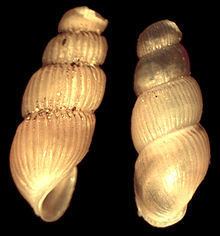Scientific name Truncatella | Superfamily Rissooidea Subfamily Truncatellinae Rank Genus | |
 | ||
Similar Truncatella subcylindrica, Assiminea, Assimineidae, Amphisphaeriaceae, Seimatosporium | ||
Truncatella is a genus of very small land snails with an operculum, terrestrial gastropod mollusks in the family Truncatellidae. These small and minute snails live on land, very close to seawater. They walk with a strange looping action, and the adults have truncated shells. Many of the species are small enough to be considered micromollusks.
Contents
Truncatella is the type genus of the family Truncatellidae.
Distribution and habitat
This genus occurs in tropical and subtropical areas. The various species of Truncatella are pantropical in distribution, with a few exceptions such as Truncatella truncatula and Truncatella subcylindrica.
Most of the species in this genus live in a habitat that is neither fully terrestrial nor fully marine: they live under plant debris near high tide level, where they are occasionally wetted with seawater by waves. A small minority of the species are fully terrestrial.
These small snails are typically found associated with drifts of plant material, where their eggs are deposited.
The adaptations of these land snails to the terrestrial environment are not so perfect as they are in the more usual pulmonate land snails, and their terrestrial adaptations may in fact be comparatively recent.
Species
The genus Truncatella was erected by Antoine Risso (Risso, 1826) for T. costulata (now T. subcylindrica), which is the type species for this genus.
There are several genera within the Truncatellidae, but the eponymous genus Truncatella is the largest (in terms of number of species); other genera in the family are Geomelania, Taheitia, and Blandiella.
There are approximately 30 species in the genus Truncatella, including:
Description
As implied by the name, these snails are notable for the way they modify their elongated shells as they mature, breaking off several of the apical whorls, and forming a relatively smooth seal for the remainder of the shell.
Locomotion
The method of locomotion used by Truncatella is unusual. Instead of gliding over a slime trail using minute waves in its foot, Truncatella uses a very large and muscular proboscis to reach ahead and grasp a surface, at which point the small foot releases its hold and the proboscis contracts to pull the animal forward, after which the entire procedure is usually repeated.
